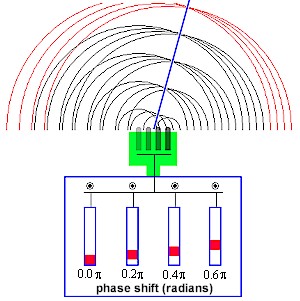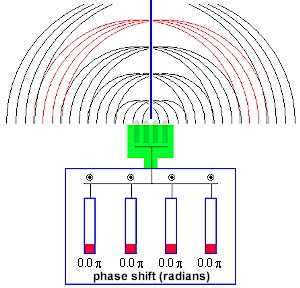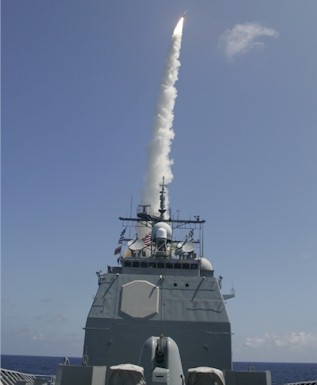|
Mainland High School
Cutting the Cord: ISTF 07-1726 |
||||||||
|
Home
Introduction Components One Two  Product Product
Three Microwave Research W. C. Brown Generators History Phased Arrays Properties Rectennas Semiconductors Solar Satellites Superconductors Moon Research Colonization Helium-3 Fusion Geography Mining Resources Project Assessment Bibliography Glossary Team |
Phased Arrays
Phased array transmission systems provide superior control of direction and mitigate unwanted electronic noise. They consist of microwave generators, wave guides, and amplifiers. Although all of the components in a phased array use the same frequency and amplitude they are out-of-phase with each other so that they can create constructive interference in the desired direction. Because of this, they do not need to physically change the angle of each element of the array, instead, changing the phase of the emitted microwaves facilitates a change in the overall angle of the beam.
Examples of phased arrays consist of military devices such as surveillance, communication devices, and complicated radar devices. In November, 2007, the University of California at San Diego announced that its electrical engineers had developed the world's most complex radio frequency integrated circuit.
UCSD's new chip packs 16 channels into a 3.2 by 2.6 mm2 chip. The input signal is divided on-chip into 16 different paths with equal amplitude and phase using an innovative design, and the phase and gain of each of the 16 channels is controlled electronically to direct the antenna pattern (beam) in a specific direction ... in nanoseconds.
One of the most prominent military devices entirely using phased arrays is the Aegis combat system. This device is capable of tracking moving targets such as enemy missiles thus enabling our Navy to intercept the missile before impact. The Aegis missile tracking system is created by combining the SPY-1 radar, the Lockheed Martin-developed MK 41 Vertical Launching System, and the SM-3 missile.4
Another military example of a phased array is Israel's Arrow. This is an anti-ballistic missile system that uses a phased array tracking system called the Green Pine Radar. This radar can aquire many targets at once with many sets of phased array modules on one very large array. Department of the Navy - DDG 51 - Arleigh Burke Class Aegic Guided-Missile Destroyer http://acquisition.navy.mil/programs/ships/ddg_51 Isreali Weapons - Arrow http://www.israeli-weapons.com/weapons/missile_systems/surface_missiles/arrow/Arrow.html Kennesaw State Univeristy - Phased Array http://physci.kennesaw.edu/javamirror/explrsci/dswmedia/parray.htm LinuxDevices.com - Real-time Linux, middlewave support U.S. Aegis systems http://www.linuxdevices.com/news/NS4667725014.html Lockheed Martin - U.S. Navy Aegis Weapon System Guides Standard Missile to Target Intercept http://www.lockheedmartin.com/news/press_releases/2003/LockheedMartinUSNavyAegisWeaponSyst_2.html Navybuddies.com - Aegis Combat System http://www.navybuddies.com/weapons/aegis.htm ScienceDaily - World's Most Complex Silicon Phased-array Chip Developed http://www.sciencedaily.com/releases/2007/10/071030135705.htm USCD Jacobs School of Engineering - Most Complex Silicon Phased Array Chip in the World Developed at UC San Diego http://www.jacobsschool.ucsd.edu/news/news_releases/release.sfe?id=701 |
|||||||



